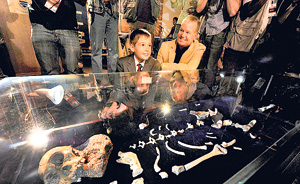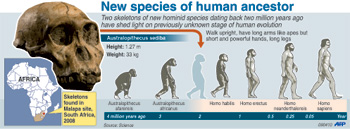MAROPENG, South Africa (AFP) - Two skeletons of a new hominid species dating back two million years and found in South Africa have shed light on a previously unknown stage in human evolution, scientists said.
Baptised Australopithecus sediba, the partially fossilized specimens -- an adult female and a juvenile male -- were found in 2008 in a cavern 40 kilometres (24 miles) from Johannesburg.
"They, ladies and gentlemen, are potentially a Rosetta stone into the past," Lee Berger, a paleo-anthropologist at the University of Witwatersrand, told a press conference at the Cradle of Humankind World Heritage Site.
"They represent a completely new and unexpected species of human ancestor to science. Something we did not think was there."The 1.9-million-year-old hominids are in "extraordinary condition", would have known each other, and were possibly related. The adult female was aged in her late 20s or early 30s and the boy between 11 and 13, he said.
"What we have found are arguably the most complete early hominid skeletons ever discovered. Each individual is far more complete than the famous Lucy fossil from Ethiopia."The hominids walked upright and share a number of traits with the first known species of homo sapiens, having long arms like apes but short and powerful hands, according to a paper to be published in the journal Science.
They have evolved pelvises, small teeth and long legs that would enable them to run like a human. It is also probable that they could climb trees.
"Australopithecus sediba appears to present a mosaic of features demonstrating an animal comfortable in both worlds," said Berger, the principal author of the paper, in an earlier telephone press conference.
Both specimens were about 1.27 metres (4 feet two inches) in height. The female weighed about 33 kilos (72.6 pounds) and the young male 27 kilos.
 |
| Prof. Lee Berger of the University of the Witwatersrand with his nine-year-old son Matthew pose near the remains of an hominid, may be one of the most significant palaeoanthropological discoveries in recent times, during its unveiling on April 8, 2010 during a press conference in Maropeng. AFP |
The species had small brains, measuring about a third of the volume of those of modern humans.
But Berger noted that the shape of their brains appears to have evolved from other species of australopithecus.
"Australopithecus sediba appears to present a mosaic of features demonstrating an animal comfortable in both worlds," said Berger, the principal author of the paper.
The new species had many physical characteristics similar to those of early hominids that would help to explain what it means to be human, he said.
The skeletal structure of the two fossils is similar to those of the first Homo species, but the new examples appear to have employed it in the same way as "Lucy," perhaps the world's most famous fossil.
Found in 1974, Lucy dated back 3.2 million years and was considered the common ancestor of humanity until the discovery of the 4.4-million-year-old "Ardi", which points to a common ancestor with the chimpanzee.
Berger said it was not possible to establish the "precise" position of the new species in relation to early man. "We can conclude that this new species shares more derived features with early Homo than any other known australopith species, and thus represents a candidate ancestor for the genus," he said.
The site of the discovery is rich in fossils and at least two other specimens of sediba have been excavated and are being analysed, Berger said.
The searchers have also identified the fossils of at least 25 other animal species, including a hyena, a wild dog, antelopes and a horse. |



